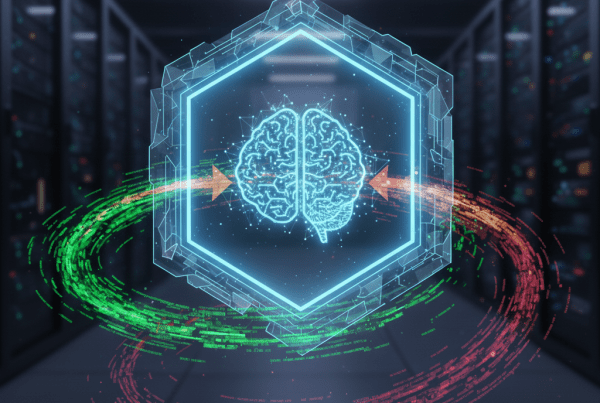Phishing, one of the oldest and most effective forms of cyberattack, has evolved significantly with the help of AI. Today, AI-driven phishing campaigns are more personalized, more convincing, and harder to detect than ever before.
In this blog, we’ll look at the evolution of phishing, how hackers are using AI to launch smarter phishing campaigns and what businesses can do to protect themselves against these advanced threats.
The Evolution of Phishing Attacks
Phishing traditionally involved sending mass emails that appeared to come from reputable sources, luring recipients into clicking malicious links or providing sensitive information. While this approach still works, it’s relatively easy to spot and block with basic security measures. Enter AI: hackers are now using machine learning and natural language processing (NLP) to automate and enhance phishing campaigns, making them far more effective.
AI allows cybercriminals to analyze massive amounts of data and craft highly targeted messages that are tailored to the individual recipient. This data might include information from social media profiles, recent transactions, or even leaked personal information from previous data breaches. The result is a convincing, well-crafted email that is difficult to distinguish from legitimate communication.
How Hackers Use AI in Phishing Campaigns
1. Automated Personalization
One of the biggest challenges for traditional phishing campaigns was the lack of personalization. Generic emails are easy to spot and are often caught by spam filters. AI has changed this by enabling attackers to personalize emails at scale. Using machine learning algorithms, cybercriminals can scrape social media profiles, public records, and even past email conversations to gather details about potential victims. This information is then used to craft emails that appear to come from trusted contacts, contain references to recent activities, or even mimic the recipient’s writing style.
For example, an AI-powered phishing email targeting a company’s finance department could mention a recent invoice or an ongoing project, making the email seem legitimate and urgent. This level of personalization significantly increases the chances that the recipient will fall for the scam.
2. Natural Language Processing (NLP)
Natural language processing is another tool in the hacker’s arsenal. With NLP, AI can generate emails that are contextually appropriate, grammatically correct, and even mirror the tone and style of legitimate communication. This makes phishing emails less likely to raise red flags. AI can also be used to create realistic dialogues in real-time, which is particularly dangerous for business email compromise (BEC) scams. In BEC scams, attackers impersonate a high-ranking executive and request urgent actions, such as wire transfers, from employees.
NLP can also be used to create voice phishing (vishing) attacks, where an AI-generated voice message is used to impersonate a company executive or a customer service representative. This adds an additional layer of authenticity to the attack.
3. Image and Voice Manipulation
Deepfake technology, which uses AI to create realistic images and videos, has introduced a new level of deception in phishing attacks. Cybercriminals can create videos or voice messages that convincingly impersonate trusted individuals. Imagine receiving a video message from your boss asking you to carry out a sensitive task; the impact and potential for deception are far greater than a traditional email.
These techniques are particularly effective in spear-phishing attacks, where the target is a specific individual or organization. By using deepfakes, attackers can bypass the usual skepticism that might accompany an email request and add a false sense of legitimacy.
4. Behavioral Analysis and Timing
AI can also be used to determine the best time to launch phishing attacks. By analyzing the target’s behavior, such as work patterns and email response times, AI can identify the optimal time to send a phishing email. This increases the likelihood that the email will be read and acted upon immediately, rather than ignored or reported as spam.
For example, an AI might determine that a particular employee typically reads emails first thing in the morning and is more likely to respond to urgent requests during that time. The phishing email would then be sent to coincide with this behavioral pattern, increasing its effectiveness.
5. The Impact on Businesses
The consequences of falling victim to an AI-driven phishing attack can be severe. Financial losses from stolen funds or intellectual property, reputational damage, and operational disruptions are just some of the potential impacts. A successful phishing attack can also lead to further compromises, such as ransomware infections or data breaches, as attackers use stolen credentials to gain deeper access to the network.
Small and medium-sized businesses (SMBs) are particularly vulnerable, as they often lack the resources and expertise to defend against such sophisticated attacks. However, large organizations are not immune, as even well-funded cybersecurity teams can struggle to detect these highly personalized phishing attempts.

How Businesses Can Protect Themselves
1. Implementing Advanced Security Measures
Businesses need to move beyond traditional security solutions and adopt advanced technologies that can detect and prevent AI-driven phishing attacks. AI-based email security tools can analyze the content, context, and metadata of emails to identify anomalies and flag potential phishing attempts. These tools use machine learning to improve over time, becoming better at detecting even the most sophisticated attacks.
Multi-factor authentication (MFA) is another essential security measure. By requiring additional verification steps, such as a text message code or biometric scan, businesses can prevent unauthorized access even if credentials are stolen.
2. Employee Training and Awareness Programs
Even the best security systems can fail if employees are not aware of the risks. Regular training sessions should be conducted to educate employees on how to recognize phishing attempts, especially those that may appear highly personalized. Phishing simulations can be an good way to test and improve employee awareness.
Training should also include information on the latest phishing techniques, such as AI-driven attacks, and emphasize the importance of not clicking on links or downloading attachments from unknown or unexpected sources.
3. Zero-Trust Security Model
A zero-trust security model operates on the principle that no one, inside or outside the network, should be trusted by default. This means that every user and device attempting to access the network must be verified and authenticated. By segmenting the network and implementing strict access controls, businesses can limit the potential damage from a successful phishing attack.
4. Regular Audits and Vulnerability Assessments
Regular security audits and vulnerability assessments can help identify and mitigate potential weaknesses in a business’s cybersecurity posture. This proactive approach ensures that security measures are up-to-date and effective against evolving threats, including AI-driven phishing campaigns.
Emerging Technologies to Combat AI-Powered Phishing
AI vs. AI: Using AI for Phishing Detection
Just as AI is being used to launch attacks, it can also be used to defend against them. AI-based threat detection systems can analyze vast amounts of data to identify patterns indicative of phishing. These systems can detect subtle anomalies in email content, sender behavior, and other factors that might be missed by traditional security tools.
Behavioral Analytics and Anomaly Detection
AI can also be used to create behavioral profiles for users, establishing a baseline of normal behavior. Any deviation from this baseline, such as an employee attempting to access sensitive data they don’t usually need, can trigger an alert. This allows businesses to detect compromised accounts before significant damage is done.
Blockchain for Email Verification
Blockchain technology offers a potential solution for verifying the authenticity of emails. By using blockchain to create an immutable record of email metadata, it becomes possible to verify the sender’s identity and ensure that the email has not been tampered with. While this technology is still in its early stages, it holds promise for reducing the effectiveness of phishing attacks.
Final Words
AI is a powerful tool that has revolutionized many industries, including cybersecurity. Unfortunately, it has also given rise to a new generation of highly sophisticated phishing attacks that are harder to detect and more damaging than ever before. Businesses must adopt a proactive approach to cybersecurity, leveraging advanced technologies and comprehensive training programs to protect themselves against these evolving threats.
As AI continues to advance, so too will the techniques used by cybercriminals. By staying informed and investing in robust security measures, businesses can defend against AI-driven phishing attacks and safeguard their data, finances, and reputation.
About Atlantic, Tomorrow’s Office
Atlantic is an award-winning office technology and IT solutions company providing Imaging Products, IT Support, Document Management, Cybersecurity and Managed Services to small and large companies in the New York City metropolitan area, and the Greater Philadelphia and Delaware Valley.
For the latest industry trends and technology insights visit ATO’s main Blog page.




